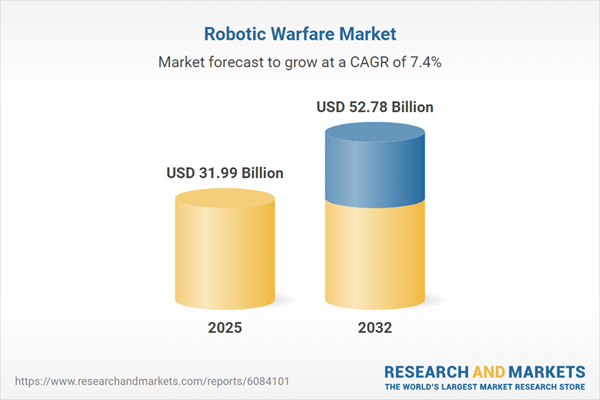Speak directly to the analyst to clarify any post sales queries you may have.
The robotic warfare market is rapidly transforming modern defense strategies, with increased focus on autonomous systems and advanced analytics across operational environments. Senior decision-makers must align technology investments and operational tactics to leverage these shifts and stay ahead in a highly dynamic sector.
Market Snapshot: Robotic Warfare Market Size and Growth
The robotic warfare market expanded from USD 29.82 billion in 2024 to USD 31.99 billion in 2025 and is projected to grow at a CAGR of 7.39%, reaching USD 52.78 billion by 2032. This growth is driven by rapid developments in autonomy, artificial intelligence, and integration of unmanned platforms in land, air, maritime, space, and underwater operations. Military organizations are adapting force structures to capitalize on unmanned systems for kinetic and non-kinetic missions, while also revising procurement and supply chain strategies to reflect these technological advances.
Scope & Segmentation: Detailed Coverage of the Robotic Warfare Market
This research provides comprehensive, actionable insight into every major facet of the robotic warfare market, equipping leaders to evaluate evolving opportunities and address sector challenges. Coverage encompasses:
- Platform Types: Aerial (fixed wing, rotary wing, hybrid, lighter than air), Ground (combat, EOD, logistics and supply, surveillance and reconnaissance), Space (communications relays—including EHF, SHF, UHF, and reconnaissance satellites with optical or radar capability, weapon platforms), Surface (displacement vessels, planing hull vessels for applications such as anti-submarine, anti-terror, mine countermeasures, and patrol), and Underwater (autonomous and remotely operated vehicles for inspection, mine countermeasures, surveillance and reconnaissance).
- Applications: Uses across combat, communication relay, EOD, logistics and supply, and surveillance and reconnaissance, deployed through aerial, ground, space, and underwater systems.
- End Users: Defense forces (air force, army, navy, space force), homeland security (border patrol, counterterrorism, maritime security), law enforcement (SWAT, urban and rural policing), and commercial users (agriculture, infrastructure inspection, media, entertainment).
- Technologies: Artificial intelligence (covering computer vision, machine learning, natural language processing), autonomy levels (fully autonomous, semi-autonomous, teleoperated), and advanced sensors (acoustic, infrared, lidar, optical, radar).
- Key Components: Control systems (onboard and remote), platforms, power systems (battery, fuel cell, hybrid, solar), sensors, and weapons (lethal, non-lethal, electronic warfare pods).
- Regional Analysis: Insight for the Americas, Europe/Middle East/Africa (EMEA), and Asia-Pacific, with focused analysis on the United States, China, India, alongside collaboration insights for Europe, the Middle East, and Latin America.
- Leading Companies: Lockheed Martin Corporation, Northrop Grumman Corporation, The Boeing Company, General Dynamics Corporation, BAE Systems plc, Leonardo S.p.A., Thales S.A., Rheinmetall AG, Elbit Systems Ltd., AeroVironment, Inc.
Key Takeaways: Strategic Insights for Senior Decision-Makers
- Advancements in autonomy algorithms and sensor integration are enabling more effective and cost-efficient deployment of unmanned systems across domains.
- Geopolitical uncertainty is leading to accelerated investment in interoperability and security of unmanned platforms, driving innovations in both supply chain resilience and system architecture.
- National security strategies must adapt to evolving global sourcing dynamics shaped by new tariff regimes, emphasizing the need for localized supply options while balancing interoperability goals.
- Operational effectiveness is being redefined by distributed control systems, swarming tactics, and the implementation of digital twin environments for real-time mission planning and logistics.
- Partnerships between industry leaders, technology startups, and academic experts are facilitating rapid development cycles and strengthening market competitiveness.
Tariff Impact: Adjusting Sourcing and Production Strategies
New tariff measures introduced in 2025 are prompting significant changes in sourcing for sensors, semiconductors, and mission-critical subsystems. Manufacturers are increasingly moving towards near-shore production and local fabrication. Decision-makers are prioritizing indigenization strategies to ensure resilience, all while maintaining interoperability for allied operations. These adjustments foster stronger, more sovereign supply chains and help safeguard national technology interests.
Methodology & Data Sources
The research draws on a hybrid approach, combining secondary sources such as defense publications, procurement records, and technical white papers with targeted interviews from industry experts, defense agencies, system integrators, and academia. Multi-source triangulation and scenario modeling ensure accuracy, supported by structured industry feedback.
Why This Report Matters: Strategic Value for Leadership
- Enables executive leaders to make informed decisions on technology adoption, procurement, and capability investments by providing forward-looking insights.
- Facilitates proactive risk management through an understanding of shifting regulatory and tariff environments, and emerging supply chain strategies.
- Supports competitive positioning via benchmarking tools and regional analysis, guiding portfolio allocation in a rapidly evolving market landscape.
Conclusion
Organizations must adapt to technological, regulatory, and global dynamics as the robotic warfare market evolves. Strategic investment and collaborative innovation are critical for maintaining operational effectiveness in this complex environment.
Table of Contents
3. Executive Summary
4. Market Overview
7. Cumulative Impact of Artificial Intelligence 2025
Companies Mentioned
The companies profiled in this Robotic Warfare market report include:- Lockheed Martin Corporation
- Northrop Grumman Corporation
- The Boeing Company
- General Dynamics Corporation
- BAE Systems plc
- Leonardo S.p.A.
- Thales S.A.
- Rheinmetall AG
- Elbit Systems Ltd.
- AeroVironment, Inc.
Table Information
| Report Attribute | Details |
|---|---|
| No. of Pages | 197 |
| Published | October 2025 |
| Forecast Period | 2025 - 2032 |
| Estimated Market Value ( USD | $ 31.99 Billion |
| Forecasted Market Value ( USD | $ 52.78 Billion |
| Compound Annual Growth Rate | 7.3% |
| Regions Covered | Global |
| No. of Companies Mentioned | 11 |









